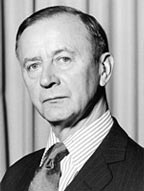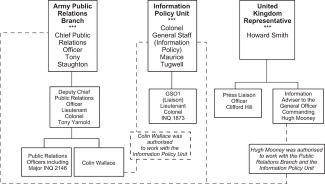Difference between revisions of "Howard Smith"
Tom Griffin (talk | contribs) (Category:State Violence and Collusion Project) |
(→Northern Ireland) |
||
| Line 18: | Line 18: | ||
[[Image:Chap181.jpg|325px|thumb|right|Information organisations in January 1972]] | [[Image:Chap181.jpg|325px|thumb|right|Information organisations in January 1972]] | ||
| − | ''The Independent'' describes Smith's role: | + | Smith occupied the post of [[UK Representative in Northern Ireland]] in 1971/2. ''The Independent'' describes Smith's role: |
| − | ::In the last months of the Stormont Assembly, he had the difficult task of acting as Whitehall's man on the spot while sending advice back to the Home Secretary. Not without personal risk, he developed a vast circle of contacts of all shades of | + | ::In the last months of the Stormont Assembly, he had the difficult task of acting as Whitehall's man on the spot while sending advice back to the Home Secretary. Not without personal risk, he developed a vast circle of contacts of all shades of opinion and preserved in his own house there a place of friendly discussion and reason through the transition to direct rule.<ref>Albert Buckley, [http://www.independent.co.uk/news/obituaries/obituary-sir-howard-smith-1346505.html Obituary: Sir Howard Smith], The Independent, 10 May 1996.</ref> |
According to Stephen Dorril, Smith invited senior [[MI6]] officer [[Frank Steele]] to be his deputy: | According to Stephen Dorril, Smith invited senior [[MI6]] officer [[Frank Steele]] to be his deputy: | ||
Latest revision as of 17:22, 8 March 2015
Howard Frank Trayton Smith(15 October 1919 - 7 May 1996). Director General of the Security Service 1978-81.[1]
Contents
Background
Early life
Smith's Independent obituary describes his early years as follows:
- The eldest of four children of a Wembley teacher, Smith won a state scholarship to the Regent Street Polytechnic in London (taking the examination a year early) and then, a year before the Second World War, an Exhibition in Mathematics to Sidney Sussex College, Cambridge.[2]
Bletchley Park
After a year at Cambridge, Smith was drafted into a team charged with breaking German ciphers at Bletchley Park, where he helped supervise the 'bombes' in Hut Six used to attack the Enigma code.[3]
Diplomatic career
Smith joined the Foreign Office after the war and was posted to New York, Norway, Washington and Caracas before returning to London as the Assistant Head of the African Department in 1956.[4]
Smith served as Head of Chancery in Moscow from 1961 to 1963, a period which included the Cuban Missile Crisis. From the 1963 to 1968 he served as head of the department dealing with the Soviet Union and Eastern Europe. He was appointed Ambassador to Czechoslovakia in the aftermath of the Soviet invasion, serving there until 1971, when he was appointed UK Representative in Northern Ireland.[5]
Northern Ireland
Smith occupied the post of UK Representative in Northern Ireland in 1971/2. The Independent describes Smith's role:
- In the last months of the Stormont Assembly, he had the difficult task of acting as Whitehall's man on the spot while sending advice back to the Home Secretary. Not without personal risk, he developed a vast circle of contacts of all shades of opinion and preserved in his own house there a place of friendly discussion and reason through the transition to direct rule.[6]
According to Stephen Dorril, Smith invited senior MI6 officer Frank Steele to be his deputy:
- A very large pipe-smoking Arabist, a veteran of Suez and the Sudan, who had recently been in Nairobi, Steele knew very little about Northern Ireland, but Smith considered he would bring a fresh approach to the post. According to Steele, he was precluded from running agents 'but was expected to use his experience of conflict situations in the Middle East and Africa'. Anthony Verrier, whose main source was also Steele, claims that this included 'covert counter-intelligence operations' which, it was argued, were required to fulfill the need to find a political solution.[7]
As UK Representative, Smith served on the Joint Security Committee chaired by Prime Minister Edward Heath.[8]
Cabinet Office and Moscow
Smith Served as Deputy Secretary of the Cabinet Office from 1972 to 1975 and as Ambassador to Moscow from 1976 to 1978.[9]
Security Service
Smith had expected to retire after serving in Moscow, but instead was appointed Director General of the Security Service by James Callaghan. He served from 1978 to 1981.[10]
Robin Ramsay and Stephen Dorril suggest that Callaghan's decision to appoint Smith rather than an inside candidate was a reflection of the chaos within MI5 in the preceding years, the era of the 'Wilson Plots'.[11]
David Leigh also reports that Smith's appointment infuriated the service's old guard, and that MI5 officer Barry Russell-Jones told Peter Wright morale was low among senior ranks.[12]
References
- ↑ Albert Buckley, Obituary: Sir Howard Smith, The Independent, 10 May 1996.
- ↑ Albert Buckley, Obituary: Sir Howard Smith, The Independent, 10 May 1996.
- ↑ Albert Buckley, Obituary: Sir Howard Smith, The Independent, 10 May 1996, accessed 2 July 2009.
- ↑ Albert Buckley, Obituary: Sir Howard Smith, The Independent, 10 May 1996.
- ↑ Albert Buckley, Obituary: Sir Howard Smith, The Independent, 10 May 1996.
- ↑ Albert Buckley, Obituary: Sir Howard Smith, The Independent, 10 May 1996.
- ↑ Stephen Dorril, MI6: Inside the Covert World of her Majesty's Secret Intelligence Service, Touchstone, 2002, P.739.
- ↑ Bloody Sunday Inquiry transcript - Day 215 - Tuesday, 28 May 2002.
- ↑ Albert Buckley, Obituary: Sir Howard Smith, The Independent, 10 May 1996.
- ↑ Albert Buckley, Obituary: Sir Howard Smith, The Independent, 10 May 1996.
- ↑ Robin Ramsay and Stephen Dorril, Smear! Wilson and the Secret State, Fourth Estate Limited, 1991, p323.
- ↑ David Leigh, The Wilson Plot, Mandarin, 1989, p.254.

